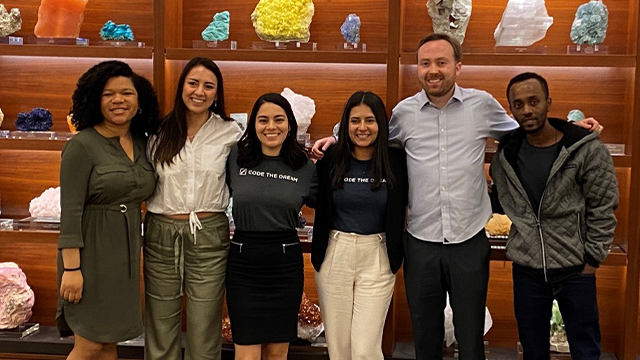In a world where technology is a cornerstone of society, opportunities in the tech sector should be within reach for all. Yet, for many people, education, resources and access barriers stand in the way.
According to research by McKinsey, Black people make up 12 percent of the US workforce but only eight percent of employees in tech jobs. Similarly, Hispanic professionals comprise 17% of the national workforce and hold just eight percent of STEM jobs. Overall, ethnic minorities have only 22% of tech jobs. That’s where Code the Dream comes in.
Founded in 2017, this transformative organization aims to shatter these barriers and make tech careers accessible to everyone. What began as a training hub and resource for DACA (Deferred Action for Childhood Arrivals) participants, has quickly expanded to serve low-income and diverse students of all backgrounds.
SAS, Code the Dream team up for Dream Fellows
With shared roots in North Carolina, SAS and Code the Dream crossed paths. In 2023, SAS expanded its work with Code the Dream by bringing on an inaugural cohort of Code the Dream Fellows. Working across two teams in SAS R&D, the fellows are using what they learned in the classroom to make a real-world impact.
At the start of the fellowship, students underwent intensive training to enhance their skills in commonly used tools and technologies at SAS, such as JavaScript, React, TypeScript, Jira, Confluence, Gerrit, Jest, Git and more. Students also had access to mentoring by field experts and teachers during their coursework.
Commenting on the partnership, Alex Boakye, Vice President of Solutions Development for SAS, stated, “Partnering with Code the Dream was an easy yes. Their mission fits the DNA of what SAS has always done: helping people grow technical talent and supporting diverse tech professionals.”
Since their training, the students have been working on fixing coding problems, creating visual examples of user interface components, testing software, checking design elements like colors and fonts and reviewing simplified designs to make sure they make sense.
They’ve also completed workshops on design thinking, accessibility and localization. Additionally, SAS leaders and executives have talked with the fellows about their career aspirations. Once they’ve completed the educational portion of the program, students are eligible to apply for a six-month paid apprenticeship where they use their learning in a real-world environment and gain professional experience.
“One of the coolest things about this program, in my opinion, is that the fellows are contributing to production code only a few months into their time with us,” commented SAS Program Manager Brad Jones. Jones continued, “Getting that kind of hands-on experience is invaluable.”
Code the Dream in action
Even before the fellows were introduced, SAS and Code the Dream have worked together to make a difference. Some of their work together has contributed to improving the literacy of American 4th graders, 40% of which are not proficient readers. This lack of literacy disproportionately impacts students of color and those from low-income families. Seeing a need for accessible intervention, SAS engineers and Code the Dream collaborated to create the Hill Reading Achievement Program (HillRAP), an app aiming to help improve literacy rates for children. SAS engineers created an iOS model-view-presenter (MVP) as the basis for the HillRAP application. Following this development, the app was migrated to a browser-based platform.
This was a game changer. Formerly, the app was only available on iPads, but Code the Dream helped make it available to anyone with internet connectivity. Teachers and students in 15 states and five countries are using the app now. Over 7,000 students with reading difficulties use the app to improve their literacy.
Supporting a diverse tech community
Impressively, this program is offered at no cost to the student. While many technology programs require a hefty upfront cost, Code the Dream relies on funding and grants to ensure its training is accessible to its students.
In the few years since its founding, Code the Dream has already made a significant impact:
- Every $1 Invested in Code the Dream equals $48 in increased earnings for participants.
- People who enroll in Code the Dream are typically unemployed or making less than $15 per hour. More than 90% of people leave the program with a job with an average salary of $70,000-$90,000.
- Code the Dream focuses on adult learners, many of whom have families. This means the program's impact tends to reach the entire family unit.
- Code the Dream started in 2017 in Durham, North Carolina and has since expanded to 32 states.
- 70% of enrolled students are black or Latinx and 65% are women.
For SAS, fostering Diversity, Equity and Inclusion in tech is essential to our DNA. SAS is continually ranked one of the best employers in the world for diversity, women, disability inclusion and overall employer inclusion. SAS takes diversity and inclusion seriously for its employees and in the industry.
"Years ago, McKinsey published a report highlighting that diverse teams are more innovative and outperform non-diverse teams. Extensive research confirms that diversity of thought, ideas and backgrounds fosters stronger organizations and promotes innovative technological advancements,” said Boakye. “Programs like Code the Dream, play a crucial role in cultivating a diverse talent pool within the industry. By investing in diverse talent, we are investing in the technology community."


